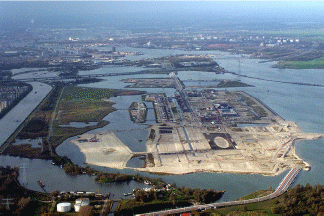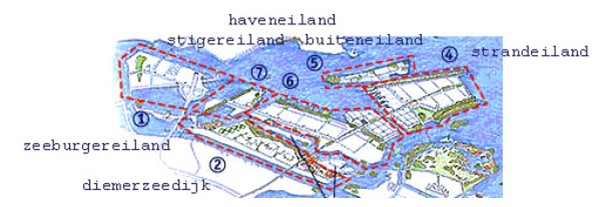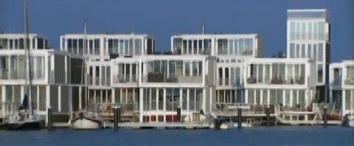Introduction
Holland is popular for its reclamation of about 7000 square kilometers of land from the sea. This aspect attracts a lot of tourists from all over the world. Their visits are aimed at witnessing the numerous windmills that have been in use since the seventeenth century for drainage.
Current draining techniques employ electric pumping stations, dykes, dams, and flood gates; however, the drainage systems are incapable of managing the expected changes in sea level due to current climatic changes (Rotmans, 2008). The engineers predict that the draining systems may be unable to prevent polders from filling up, which will increase the risk for majority of its population that lives below the sea level.
As a result, Netherlands has sought to find new and flexible ways of managing the fluctuating water levels within the polder areas (Akkermans, Gout, van Loon, Oladunjoye, & de Visser, 2008).
This paper examines the hybrid system, which comprises a partly floating, partly fixed society that is being implemented as a replacement of the current draining system. The floating city of Ijburg is designed to float in various instances such as in the event of a rise in the water level due to storm surges or extreme precipitation.
Background
The current network of dykes, dunes and dams used to maintain dry land in Netherlands is adequate for the control of low risk flooding. However, the impact of global warming on climate change and sea level has threatened the conventional way of living in Holland.
The government of Holland estimates that by the year 2100, there will be a one meter rise in sea level due to global warming alone, and an extra 0.5 meters due to storm surges and underground subsidence. Calculations show that an increase in sea level by over 0.5 meters significantly increases the risk of flooding (Mols, 2005).
In addition, the population increase has continued to exert pressure on available land for settlement, which has made the need for new land more urgent than before (Anderson, 2000). This problem was acknowledged more than ten years ago, leading to the initiation of the idea to develop neighborhoods in the water.
The floating city
The Ijburg design project was designed as a series of man-made islands that could provide housing for over 50,000 residents of Amsterdam. The design of the floating city of Ijburg suggested that the construction process was to take place between 1997 and 2015. The city, which is in Ijmeer, covers 450 hectares. Ijburg has a close proximity to the city center, which will provide good public transport facilities.
Its closeness to reliable transport networks is due to the nature of its high density housing, which limits commuting by car within the suburb. According to Geurs and wee (2004), the design includes six islands around the Ijburg bay that will be formed by building a “polder, Haveneiland, two Rieteilanden, Strandeiland and Buiteneil, which will then be leveled and filled”.
The design of Ijburg was done with consideration of the manner in which it would co-exist with neighboring cities (Gryglewicz, 2003). For instance, Zeeburgereiland will form the link between the city of Amsterdam and the new Ijburg district, through which all means of transport will be channeled. Diemerzeedijk will have a recreational purpose, whereby a park, sport field, beach area, and national reserve will be created.
The Rieteilanden will form two residential islands with the option of individual houses, while Strandeiland will provide a recreational area for Amsterdam dwellers. Buiteneiland, Haveneiland, and Steigereiland will be used to provide a variety of houses including apartments and single family houses (Geurs & Wee, 2004).
Statistics
Ijburg is the largest community of its kind in the world. The architecture of the city is managed by “Waterstudio”, which has been involved in the design and construction of various floating structures including a cruise ship terminal, a golf course, and a prison. The innovative construction has transformed the manner in which low-lying cities plan their urban structures.
The construction of Ijburg city is estimated to cost $2 billion. “The completion of the eight man-made islands and 150 floating structures will contribute more than 1000 acres of real estate to the capital” (Science Discovery, 2011). The city is expected to provide about 18,000 homes for an estimated 45,000 people, in addition to other floating neighborhoods (Science Discovery, 2011).
The construction of the floating structures takes place on dry land before being moved and installed on the man-made islands (Projectbureau IJburg, 2012). One of the primary structures on the floating city is the Waternet office building, which is over 100 feet long and 30 feet high.
The Waternet office building is located at the center of the city, and serves as a symbol of green engineering, owing to the use of energy-efficient systems that make it a trend setter in ecological building of floating structures (Lindgren, 2011). The complexities in construction of this structure are due to its mobile nature, which means that the engineers need to prevent collisions with bridges or canal walls (Science Discovery, 2011).
Pictures



Opinion on the structure
The success of Ijburg city will lead to new ways of urban planning for low-lying cities. The construction process involves innovative processes in extreme engineering. The first step involves the construction of a seamless concrete foundation. Its stability provides sufficient support for the construction of structures that are several times the size of previously built floating houses (Lindgren, 2011).
Ijburg city comprises structures of all kinds including one-story housing units, intricate luxury villas, office buildings, floating restaurants, and floating hotels. The concept of building floating structures is quite daring and interesting at the same time.
The designers of floating structures have had to strategize more than their counterparts who construct on solid ground, especially since the concept of floating structures has not been tested for a long period of time.
The engineers involved in the construction of Ijburg have encountered various challenges that land designers rarely face, including how to keep the homes from sinking and capsizing, as well as, ways of ensuring balance of the homes so that they remain upright at all times (Dac&Ciities, 2012).
The success of the floating city and its structures depends on the consideration of all factors during the construction process including hook-up functions and setting up of utilities. While the uptake of the houses has been slower than expected, the architects are optimistic that the Dutch will continue to appreciate the design and convenience of the structures with regard to controlling the fluctuating water levels inside the polders.
Glossary
- Apartments: housing units in a block.
- Beach area: region surrounding the sea.
- Capsize: submerge in water.
- Dam: a reservoir to regulate water movement.
- Dyke: artificial wall to regulate water.
- Ecological building: structures that make use of natural energy such as lighting.
- Extreme precipitation: excessive weather pattern in the form of rain or snow.
- Floating city: suspended structures.
- Global warming: heating of earth’s atmosphere due to greenhouse effect.
- Green engineering: practices that are sensitive of preserving the environment.
- Hook-up functions: matters pertaining to connectivity and access.
- Hybrid system: an enhanced system.
- Low-lying cities: cities located at very low altitude, possibly below sea level.
- National reserve: a region of land preserved by state.
- Polder: low-lying tract of land enclosed by barriers.
- Real estate: housing projects.
- Reclamation: transforming to better use.
- Single family houses: housing units for family setting.
- Storm surges: sudden bursts of heavy downpour.
- Utilities: amenities such as water and electricity.
Notes
Notes from the YouTube video of Amsterdam’s Futuristic Floating City by Extreme Engineering
- Most of Netherlands is positioned below sea level, which implies that majority of its population also live below sea level. The expected rise in water level in coming decades due to climatic changes has led to the need for innovative ways of dealing with the fluctuations in sea level.
- The floating city of Ijberg is built in lake Ij.
- Construction started in 1997, and the completion date was moved from 2012 to 2015 due to the slow uptake of the housing by Amsterdam dwellers.
- One of the Designers, Danny Forster, expresses his excitement in the construction exercise, which involves ecological structures designed on land and fitted into position inside the water.
- The construction of a beach in the floating city involves the deposition of sand up to the surface level.
- The buildings and structures are accurately positioned to prevent them from shifting during strong winds. The design ensures stability of structures to prevent them from colliding with the lightly constructed dyke walls or bridges that link different structures. (Lindgren, 2011).
- Settlement in the floating city of Ijberg started in 2002 in three of the artificial islands namely Rietteiland, Haveneiland, and Steigereiland.
References
Akkermans, C., Gout, J., van Loon, M., Oladunjoye, D., & de Visser, P. (2008). The floating City. Technology in Sustainable Development. Web.
Anderson, S. (2000). The Cultural Creatives. New York: Harmony Books.
Dac&Ciities. (2012). Ijburg: City Of Islands. Web.
Geurs, K., & Wee, G. V. (2004). Backcasting as a tool for sustainable transport policy making: the environmentally sustainable transport study in the Netherlands. European Journal of Transport and Infrastructure Research, 4(1), 47-69.
Gryglewicz, A. (2003). Ijburg, amsterdam. ‘cities on water’- planned projects. Web.
Lindgren, A. (Director). (2011). Amsterdam Futuristic floating city [Motion Picture]. Amsterdam, Netherlands: Extreme Engineering.
Mols, B. (2005). ‘Wave Power. Delft Outlook, 1(1), 2-5.
Projectbureau IJburg. (2012). Project Ijburg. Web.
Rotmans, J. (2008). The Floating City: into an ocean of opportunities. Urgenda. Web.
Science Discovery. (2011). Ijburg: First-Ever Floating City. Web.